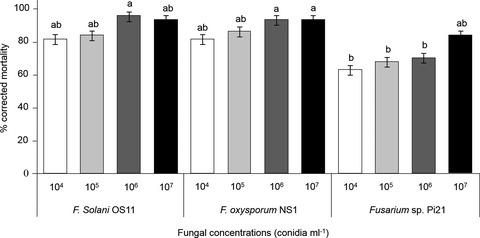当前位置:
X-MOL 学术
›
Entomol. Exp. Appl.
›
论文详情
Our official English website, www.x-mol.net, welcomes your
feedback! (Note: you will need to create a separate account there.)
Pathogenicity of Fusarium spp. isolates against the Mediterranean fruit fly (Ceratitis capitata) and their responses to ultraviolet‐B radiation and water stress
Entomologia Experimentalis et Applicata ( IF 1.4 ) Pub Date : 2021-02-12 , DOI: 10.1111/eea.13033 Ayoub Hallouti 1 , Mohamed Ait Hamza 2 , Hafsa Tazi 1, 2 , Rachid Ait Hammou 1 , Abdelaziz Zahidi 2 , Abdellah Ait Ben Aoumar 1 , Hassan Boubaker 1
Entomologia Experimentalis et Applicata ( IF 1.4 ) Pub Date : 2021-02-12 , DOI: 10.1111/eea.13033 Ayoub Hallouti 1 , Mohamed Ait Hamza 2 , Hafsa Tazi 1, 2 , Rachid Ait Hammou 1 , Abdelaziz Zahidi 2 , Abdellah Ait Ben Aoumar 1 , Hassan Boubaker 1
Affiliation

|
Successful application of entomopathogenic fungi as biocontrol agents requires a selection of highly virulent isolates with the ability to tolerate abiotic stress factors. Herein, we evaluated the entomopathogenic activity as well as the effect of ultraviolet‐B radiation (UV‐B) and water stress on conidia germination, viability, and fungal growth of three Fusarium isolates, namely Fusarium oxysporum NS1, F. solani OS11, and Fusarium sp. Pi21. Pathogenicity was tested against pupae and adults of the Mediterranean fruit fly, Ceratitis capitata Wiedemann (Diptera: Tephritidae), by spraying and by body‐contact bioassays, respectively. Average mortality of treated individuals ranged from 62 to 93% for pupae and from 26 to 86% for adults, depending on the fungal isolate and concentration. The highest mortality rates were caused by F. oxysporum NS1 and F. solani OS11. These isolates were effective within a short time period (LT50, pupae: <87 h, adults: <68 h) using low concentrations (LC90, pupae: <7 × 105 conidia ml−1, adults: <5 × 106 conidia ml−1). Sensitivity to UV‐B and water activity (aw) varies significantly among the studied isolates. Fusarium oxysporum NS1 was the most tolerant to UV exposure and water stress, with >63% relative conidia germination and growth rates after 6 h UV exposure and >50% conidia germination and viability at aw = 0.928. These results showed the high pathogenicity of Fusarium isolates, especially F. oxysporum NS1, against C. capitata and their tolerance to abiotic stress conditions. However, the application of these isolates in the field as biopesticides requires further studies elucidating their specificity toward C. capitata and their safety for non‐target organisms.
中文翻译:

镰刀菌的致病性。分离物对抗地中海果蝇(Ceratitis capitata)及其对紫外线-B辐射和水分胁迫的反应
昆虫病原真菌作为生物防治剂的成功应用需要选择具有高耐受力的非生物菌株,这些菌株具有耐受非生物胁迫因素的能力。在这里,我们评估了昆虫病原学活性以及紫外线B辐射(UV-B)和水分胁迫对三种镰刀菌枯萎病菌镰刀菌NS1,F的分生孢子萌发,活力和真菌生长的影响。solani OS11和Fusarium sp。Pi21。测试了针对against和地中海实蝇成年大角藻的成虫的致病性Wiedemann(Diptera:Tephritidae),分别通过喷雾和身体接触生物测定法。根据真菌分离物和浓度,治疗后treated的平均死亡率为mortality的62%至93%,成年人的26%至86%。最高的死亡率是由尖孢镰刀菌NS1和茄形镰刀菌OS11引起的。这些分离株在低浓度(LC 90,p:<7×10 5分生孢子ml -1,成人:<5×10 )下,在短时间内(LT 50,p:<87 h,成人:<68 h)有效。6分生孢子ml -1)。在研究的菌株中,对UV-B和水活度(aw)的敏感性差异很大。尖孢镰刀菌NS1对紫外线和水分胁迫耐受性最强,在紫外线照射6 h后相对分生孢子萌发和生长速率> 63%,在w = 0.928时分生孢子萌发和存活率> 50%。这些结果表明镰刀菌分离物,特别是F具有很高的致病性。尖孢霉NS1,针对头孢梭菌及其对非生物胁迫的耐受性。但是,这些分离物作为杀生物剂在野外的应用需要进一步研究,阐明它们对衣原体的特异性及其对非靶标生物的安全性。
更新日期:2021-02-12
中文翻译:

镰刀菌的致病性。分离物对抗地中海果蝇(Ceratitis capitata)及其对紫外线-B辐射和水分胁迫的反应
昆虫病原真菌作为生物防治剂的成功应用需要选择具有高耐受力的非生物菌株,这些菌株具有耐受非生物胁迫因素的能力。在这里,我们评估了昆虫病原学活性以及紫外线B辐射(UV-B)和水分胁迫对三种镰刀菌枯萎病菌镰刀菌NS1,F的分生孢子萌发,活力和真菌生长的影响。solani OS11和Fusarium sp。Pi21。测试了针对against和地中海实蝇成年大角藻的成虫的致病性Wiedemann(Diptera:Tephritidae),分别通过喷雾和身体接触生物测定法。根据真菌分离物和浓度,治疗后treated的平均死亡率为mortality的62%至93%,成年人的26%至86%。最高的死亡率是由尖孢镰刀菌NS1和茄形镰刀菌OS11引起的。这些分离株在低浓度(LC 90,p:<7×10 5分生孢子ml -1,成人:<5×10 )下,在短时间内(LT 50,p:<87 h,成人:<68 h)有效。6分生孢子ml -1)。在研究的菌株中,对UV-B和水活度(aw)的敏感性差异很大。尖孢镰刀菌NS1对紫外线和水分胁迫耐受性最强,在紫外线照射6 h后相对分生孢子萌发和生长速率> 63%,在w = 0.928时分生孢子萌发和存活率> 50%。这些结果表明镰刀菌分离物,特别是F具有很高的致病性。尖孢霉NS1,针对头孢梭菌及其对非生物胁迫的耐受性。但是,这些分离物作为杀生物剂在野外的应用需要进一步研究,阐明它们对衣原体的特异性及其对非靶标生物的安全性。











































 京公网安备 11010802027423号
京公网安备 11010802027423号